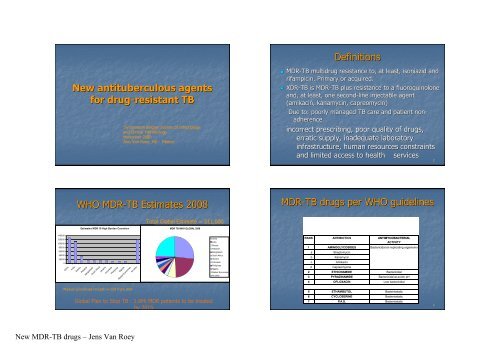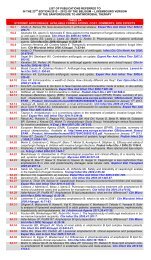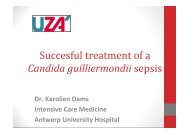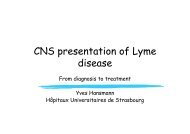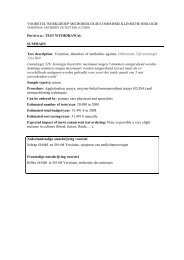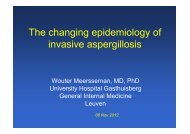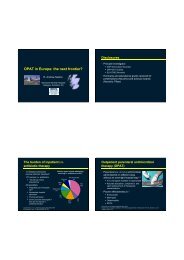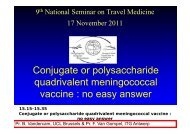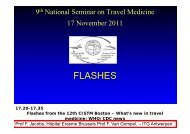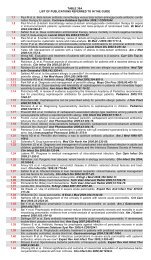Mr J. Van Roey, Tibotec
Mr J. Van Roey, Tibotec
Mr J. Van Roey, Tibotec
You also want an ePaper? Increase the reach of your titles
YUMPU automatically turns print PDFs into web optimized ePapers that Google loves.
New antituberculous agents<br />
for drug-resistant resistant TB<br />
Symposium Belgian Society of Infectiology<br />
and Clinical Microbiology<br />
November 2009<br />
Jens <strong>Van</strong> <strong>Roey</strong>, MD - <strong>Tibotec</strong><br />
Definitions<br />
• MDR-TB multidrug resistance to, at least, isoniazid and<br />
rifampicin. Primary or acquired.<br />
• XDR-TB is MDR-TB plus resistance to a fluoroquinolone<br />
and, at least, one second-line injectable agent<br />
(amikacin, kanamycin, capreomycin)<br />
Due to: poorly managed TB care and patient non-<br />
adherence.<br />
incorrect prescribing, poor quality of drugs,<br />
erratic supply, inadequate laboratory<br />
infrastructure, human resources constraints<br />
and limited access to health<br />
services<br />
2<br />
WHO MDR-TB Estimates 2008<br />
MDR-TB drugs per WHO guidelines<br />
Total Global Estimate = 511,000<br />
Estimates MDR 10 High Burden Countries<br />
MDR TB WHO GLOBAL 2008<br />
140000<br />
120000<br />
100000<br />
80000<br />
60000<br />
40000<br />
20000<br />
0<br />
China<br />
India<br />
Russia<br />
Pakistan<br />
Bangladesh<br />
South Africa<br />
Ukraine<br />
Indonesia<br />
Phillipines<br />
Nigeria<br />
Market Economies<br />
All other<br />
Series1<br />
China<br />
India<br />
Russia<br />
Pakistan<br />
Bangladesh<br />
South Africa<br />
Ukraine<br />
Indonesia<br />
Phillipines<br />
Nigeria<br />
Market Economies<br />
All other<br />
RANK ANTIBIOTICS ANTIMYCOBACTERIAL<br />
ACTIVITY<br />
1 AMINOGLYCOSIDES Bactericidal on replicating organisms<br />
a<br />
b<br />
c<br />
d<br />
Streptomycin<br />
Kanamycin<br />
Amikacin<br />
Capreomycine<br />
2 ETHIONAMIDE Bactericidal<br />
3 PYRAZINAMIDE Bactericidal at acidic pH<br />
4 OFLOXACIN Low bactericidal<br />
Market economies include n=159 from USA<br />
Global Plan to Stop TB : 1.6Mi MDR patients to be treated<br />
by 2015<br />
5 ETHAMBUTOL Bacteriostatic<br />
6 CYCLOSERINE Bacteriostatic<br />
7 P.A.S. Bacteriostatic<br />
4<br />
New MDR-TB drugs – Jens <strong>Van</strong> <strong>Roey</strong>
Treatment outcomes in MDR-TB<br />
8506 pts/33<br />
studies<br />
Success Failure Default Death<br />
Individualized 64 6 12 11<br />
standardized 54 18 12 11<br />
Criteria leading to enhanced success, if combined 69% success rate<br />
•Treatment duration of at least 18 months<br />
•Use of DOT strategy throughout<br />
Criteria with no effect on treatment outcome<br />
•Number of resistant drugs in the regimen<br />
•Number of drugs<br />
•% receiving fluoroquinolones<br />
•HIV prevalence<br />
Overview new MDR-TB drugs<br />
• Fluoroquinolones: moxi- and gatifloxacin<br />
• Oxazolidinone: Linezolid, PNU-100840<br />
• Nitro-imidazoles: imidazoles: PA-824 and OPC-67683<br />
• Diamines or Ethambutol derivatives: SQ109<br />
• Diarylquinolines: TMC207<br />
E. Orenstein et al. Lancet Inf Dis, March 2009<br />
5<br />
6<br />
Moxifloxacin vs. Ethambutol<br />
Chaisson ICAAC 2007<br />
HRZ+ethambutol or moxifloxacin<br />
170 patients, 146 analyzed<br />
% negative cultures<br />
p=0.021<br />
Fluoroquinolones<br />
weeks<br />
7 8<br />
New MDR-TB drugs – Jens <strong>Van</strong> <strong>Roey</strong>
Moxifloxacin, gatifloxacin vs. EMB (OFLOTUB Study)<br />
Moxifloxacin vs. INH<br />
Dorman, , ICAAC 2007<br />
• RZE + isoniazid or moxifloxacin<br />
• 433 patients, 344 (79%) analyzed<br />
• 252 (73%) excavation+, 36 (11%) VIH+<br />
Moxifloxacin : 60% (103/171) culture negative at 2 months<br />
Isoniazid : 55% (93/173) cultures negative at 2 months<br />
p=0,37<br />
poor results due to improved culture techniques<br />
Rustomjee et al. 2008. IJTLD. 9<br />
10<br />
Moxi- , Gatifloxacin<br />
• MIC: 0.03 – 0.5 µg/ml<br />
• Mainly being investigated for DS-TB and<br />
treatment shortening potential (time to<br />
conversion analysis)<br />
• M substitutes H or E, G substitutes E in phase<br />
II/III trials<br />
• Cross-class resistance issues<br />
• Concerns M has QT prolongation effect and G<br />
has dysglycemia effects 11<br />
Oxazolidinones<br />
12<br />
New MDR-TB drugs – Jens <strong>Van</strong> <strong>Roey</strong>
Linezolid<br />
• MIC = 0.5 µg/ml (Alcala, AAC 2003)<br />
• Mechanism of action : inhibition of the synthesis of<br />
proteins by blocking the initiation complex<br />
• Pharmacokinetics (Gee, AAC 2001) at 600 mg x 2/day<br />
• Cmax = 18 µg/ml<br />
• Half-life life = 5 hours<br />
• Time dependant activity (40%>MIC)<br />
• Absorption interaction with H and Z<br />
13<br />
CFU counts (log10) in the lungs<br />
9<br />
8<br />
7<br />
6<br />
5<br />
Placebo<br />
4<br />
Linezolid, 50<br />
3<br />
Linezolid, 100<br />
2<br />
PNU, 50<br />
1<br />
PNU,100<br />
0<br />
Weeks<br />
0 4<br />
Activity of Oxazolidinones in the<br />
mouse model.<br />
Cynamon et al. 1999. AAC.<br />
14<br />
PNU-100480<br />
• Currently in Phase I trials<br />
• In murine model both bactericidal and<br />
sterilizing activity, resulting in treatment<br />
shortening potential<br />
• R+PNU is equally effective as R+H+PNU in<br />
continuation phase<br />
• No cross-resistance resistance with existing TB-drugs<br />
Relapse assessment Linezolid vs<br />
PNU-100480<br />
Proportion (%) of mice with relapse after treatment<br />
Treatment group 3 mths 4 mths 6 mths<br />
2RHZ + 4RH n.d. 18 of 20 (90) 0 of 20 (0)<br />
2RHZU + 2RHU 9 of 20 (45) 1 of 20 (5) n.d.<br />
2RHZU + 2RU 7 of 20 (35) 1 of 20 (5) n.d.<br />
2RHZU + 2RH 17 of 20 (85) 7 of 20 (35) n.d.<br />
2RHZL + 2RHL n.d. 20 of 20 (100) n.d.<br />
15<br />
2RHZL + 2RH n.d. 20 of 20 (100) n.d.<br />
16<br />
New MDR-TB drugs – Jens <strong>Van</strong> <strong>Roey</strong>
Conclusions<br />
• Linezolid displays a limited (bacteriostatic)<br />
activity in vitro, in the mouse model and in<br />
patients.<br />
• PNU-100480 has sterilizing activity in the<br />
murine model and may be capable of<br />
shortening treatment duration for DS as well<br />
as MDR-TB<br />
Nitro-imidazoles<br />
imidazoles<br />
17<br />
18<br />
PA-824 and OPC-67683<br />
Activity of PA-824 alone against M.<br />
tuberculosis in mice<br />
MIC vs. M. tuberculosis H37Rv<br />
(μg/ml) g/ml)<br />
Isoniazid 0.05<br />
PA-824<br />
0.015-0.25<br />
0.25<br />
OPC-67683 0.006-0.024<br />
0.024<br />
Rifampicin 0.25<br />
• Metronidazole derivatives<br />
• Active on DS-TB and MDR-TB<br />
strains.<br />
• Inhibition of cell wall lipids and<br />
protein synthesis<br />
• No cross resistance with<br />
standard TB-drugs<br />
• Cross resistance with PA-824<br />
CFU counts (log10) in the lungs<br />
12<br />
10<br />
8<br />
6<br />
4<br />
2<br />
0<br />
-20 0 56<br />
control<br />
RHZ<br />
H<br />
PA-824<br />
H + PA<br />
Days<br />
Tyagi et al. 2005. AAC.<br />
19 20<br />
New MDR-TB drugs – Jens <strong>Van</strong> <strong>Roey</strong>
Early Bactericidal Activity of PA-824 in patients<br />
with pulmonary tuberculosis<br />
Conclusions<br />
21<br />
• PA-824 :<br />
• MIC: 0.015 – 0.25 µg/ml<br />
• No cross resistance with anti-TB drugs but cross<br />
resistance with OPC-67683.<br />
• When used at 100 mg/kg in mice, similar activity<br />
than that of INH .<br />
• Can not shorten DS-TB treatment in the mouse<br />
model.<br />
• In patients, limited EBA. Phase II started.<br />
22<br />
Activity of OPC-67683 against M.<br />
tuberculosis in the mouse model.<br />
Early Bactericidal Activity of OPC-67683 in<br />
patients with pulmonary tuberculosis<br />
•<br />
23<br />
24<br />
New MDR-TB drugs – Jens <strong>Van</strong> <strong>Roey</strong>
Conclusions<br />
• OPC-67683 :<br />
• MIC 0.006 – 0.024 µg/ml<br />
• No cross resistance with anti-TB drugs but cross<br />
resistance with PA-824.<br />
• Much more active than PA-824 in the mouse<br />
model.<br />
• Potential to shorten treatment duration<br />
• In patients, limited EBA. Phase II ongoing<br />
Ethambutol derivatives<br />
25<br />
26<br />
Activity of SQ109 against M.<br />
tuberculosis in the mouse model<br />
Nikonenko et al. 2007. AAC.<br />
Conclusions<br />
• MIC: 0.16-0.64<br />
0.64µg/ml DS and MDR-TB<br />
• Inhibition cell wall synthesis<br />
• No cross resistance with ethambutol or any<br />
first line TB drug (H, R, Z)<br />
• In the mouse model, the addition of SQ109 to<br />
RHZ is more effective than RHZ.<br />
• Phase I multidose safety study started in 2009<br />
27 28<br />
New MDR-TB drugs – Jens <strong>Van</strong> <strong>Roey</strong>
J accelerates bacterial killing<br />
when added to SOC for MDR TB<br />
7<br />
Diarylquinolines<br />
6<br />
5<br />
4<br />
3<br />
2<br />
1<br />
H = isoniazid<br />
R = rifampin<br />
Z = pyrazinamide<br />
J = R207910 (TMC207)<br />
A= amikacin<br />
Et= Ethionamide<br />
M= moxifloxacin<br />
Z= pyrazinamide<br />
0<br />
controls<br />
D12<br />
HRZ<br />
HRZ+J<br />
4 wks<br />
AEtMZ AEtMZ+J 8 wks<br />
Lounis et al. 2006. AAC.<br />
30<br />
EBA with TMC207<br />
Activity of TMC207 in MDR-TB patients<br />
Changes in cfu counts over time with 95% CL<br />
start TMC207,<br />
placebo<br />
end TMC207,<br />
placebo<br />
double-blind phase<br />
BR alone for 12-18 m<br />
Confirmed MDR<br />
TB<br />
8 weeks<br />
Stage I n=47<br />
24 weeks<br />
Stage II n=150<br />
2 y follow-up<br />
BR regimen: kanamycin, FQ, ethionamide, PZA, cycloserine<br />
31<br />
32<br />
New MDR-TB drugs – Jens <strong>Van</strong> <strong>Roey</strong>
Time to culture conversion (MGIT) on ITT<br />
population (n=44)<br />
Mean (±(<br />
SD) log 10 CFU count (SSCC)<br />
p = 0.003<br />
(a) p-value from Cox proportional model adjusting for strata<br />
33<br />
34<br />
Conclusions<br />
• MIC: 0.03µg/ml<br />
• No cross-resistance resistance with existing TB drugs<br />
• Potential for treatment shortening<br />
• Sterilizing activity in mouse model<br />
• In patients : EBA limited activity, good activity<br />
in phase II<br />
BACK-UP SLIDES<br />
35<br />
36<br />
New MDR-TB drugs – Jens <strong>Van</strong> <strong>Roey</strong>
EBA of linezolid<br />
Dietze et al. 2008. AJRCCM.<br />
EBA of linezolid<br />
Dietze et al. 2008. AJRCCM. AJRCCM.<br />
37<br />
38<br />
Linezolid : in patients<br />
In vitro activity of TMC207<br />
• Clinical use of linezolid (Fortun, JAC 2005)<br />
• 5 patients treatead with linezolid + thiacetazone, clofazimine or o<br />
amoxicilline/clavulanate.<br />
• All the isolates were sensitive in vitro (MIC 0.5 mg/L).<br />
• Negativation of the sputum culture s after 6 weeks of<br />
treatment .<br />
• 3 cures (duration of treatment : 5-245<br />
months).<br />
• 1 lost to follow –up after 5 months of treatment.<br />
• 1 patient under treatment after 11 months.<br />
• 4 patients with anemia that need transfusions<br />
• 2 peripherial neuropathies<br />
• 1 pancreatitis<br />
39<br />
Non-mycobacteria:<br />
MIC 4 g/ml<br />
• St. aureus<br />
• Str. Pyogenes<br />
• E. faecalis<br />
• E. faecium<br />
• S. typhimurium<br />
• E. coli<br />
• P. aeruginosa<br />
• H. influenzae<br />
• H. pylori<br />
• M. pneumoniae<br />
Andries et al. 2005, Science<br />
Br<br />
N<br />
O<br />
O H<br />
R207910<br />
TMC207<br />
Compound J<br />
N<br />
Mycobacteria:<br />
MIC 0.060<br />
g/ml<br />
• M. tuberculosis<br />
• MDR M. tuberculosis<br />
• M. bovis<br />
• M. avium<br />
• M. kansasii<br />
• M. fortuitum<br />
• M. marinum<br />
• M. smegmatis<br />
40<br />
New MDR-TB drugs – Jens <strong>Van</strong> <strong>Roey</strong>
ATP Synthase (cible du R207910)<br />
Diarylquinoline : R207910 (TMC207)<br />
Inhibition of<br />
ATP synthase<br />
Subunit c<br />
(atpE)<br />
41<br />
Andries et al.<br />
2005, Science<br />
42<br />
Percentage of mice relapsing after treatment of MDR-TB<br />
Percentage of<br />
mice with<br />
positive cultures<br />
60<br />
50<br />
40<br />
30<br />
20<br />
10<br />
0<br />
2RHZ+4RH<br />
11<br />
Percentage of mice relapsing after treatment<br />
16<br />
2JRZ+2JR<br />
Relapse rates (%) 4 months<br />
40<br />
2JMZ+4JM<br />
11<br />
2AEtMZ+4EtM<br />
58<br />
Relapse rates (%) 6 months<br />
2JAEtMZ+4JEtM<br />
28<br />
43<br />
Ibrahim et al. 2008, ICAAC<br />
6<br />
5<br />
4<br />
3<br />
2<br />
1<br />
Activity of TMC207 in the mouse model<br />
TMC207 (J) in combination therapy<br />
Number of Bacteria<br />
in Lungs (Log 10CFU)<br />
0<br />
Controls<br />
D12<br />
R H Z<br />
R H Z J<br />
5 logs drop<br />
in 4 weeks<br />
R H J<br />
Z<br />
R = rifampin 10 mg/kg<br />
H = isoniazid 25 mg/kg<br />
Z = pyrazinamide 150 mg/kg<br />
J = JNJ 25 mg/kg<br />
R J Z<br />
Accelerated Drop in Bacterial Load<br />
H<br />
J H Z<br />
R<br />
8 wks<br />
4 wks<br />
44<br />
New MDR-TB drugs – Jens <strong>Van</strong> <strong>Roey</strong>
Percentage of mice relapsing after treatment of Drug<br />
Susceptible -TB<br />
Microbiology data in mice and patients<br />
Percentage of mice with positive lung cultures<br />
90<br />
80<br />
70<br />
60<br />
50<br />
40<br />
30<br />
20<br />
10<br />
0<br />
2RHZ/4RH<br />
17<br />
84<br />
2RMZ/RM<br />
42<br />
56<br />
28<br />
2JRZ/JR<br />
13<br />
72<br />
68 67<br />
2JHZ/JH<br />
29<br />
35<br />
2JRHZ/JRH<br />
6<br />
2mo<br />
3mo<br />
4mo<br />
6mo<br />
Log CFU in lungs<br />
8<br />
7<br />
6<br />
5<br />
4<br />
3<br />
2<br />
1<br />
0<br />
Efficacy in Mice<br />
0 2 4 6 8<br />
weeks<br />
Lounis et al. AAC. 2006<br />
AEtMZ<br />
AEtMZ+ TMC<br />
Log CFU in sputum<br />
8<br />
7<br />
6<br />
5<br />
4<br />
3<br />
2<br />
1<br />
0<br />
Efficacy in MDR TB patients<br />
KEtOZ+TMC<br />
KEtOZ<br />
0 2 4 6 8<br />
Weeks<br />
Diacon et al. NEJM. 2009<br />
45<br />
Veziris et al. ICAAC, 2007<br />
A= amikacin Et=ethionamide M=moxifloxacin Z=pyrazinamide K= kanamycin O=ofloxacin<br />
46<br />
New MDR-TB drugs – Jens <strong>Van</strong> <strong>Roey</strong>


